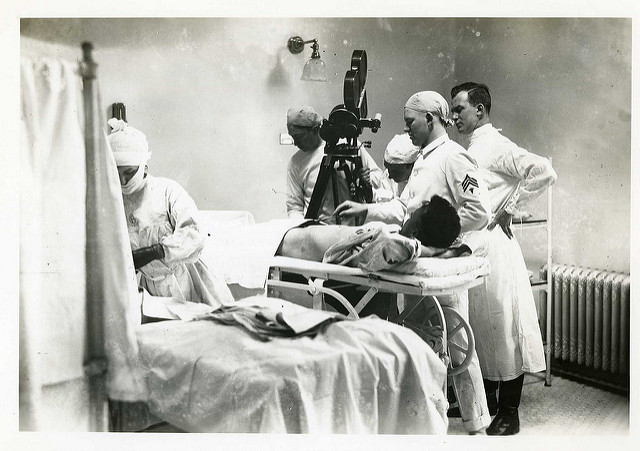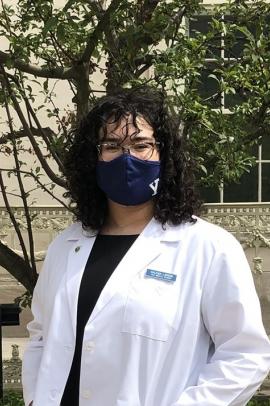Surgery for an acute abdomen – an intriguing history of the laparotomy procedure.

A laparotomy procedure is a common surgical technique, especially in an emergency setting. Defined as the making of an incision into the abdominal wall to access the abdominal or pelvic cavity, a laparotomy can be explorative, therapeutic or emergency. Since the 1980s, pioneering laparoscopic approaches have revolutionised the procedure, resulting in lower post-operative infection rates. However, it is a versatile operation, with a little-known history that far pre-dates modern times. Its origins tells us much about the history of surgery in general, as well as about the progress over the last 100 years surrounding women’s health, obstetric and gynaecological emergencies.
This article attempts to briefly chart the history of the laparotomy; unpacking evidence and exploring cases that are certain, and some that are less certain. This article attests that this operation is an ancient procedure, which almost inevitably was fatal until the routine use of antiseptic and aseptic surgical techniques and anaesthesia at the end of the 19th century.
It is intriguing to note that the first documented successful laparotomy was performed well before the advent of modern surgical techniques, in 1809. It was performed in Kentucky, by the surgeon Ephraim McDowell [1]. A lesser known figure today, Ephraim McDowell has been dubbed “the father of ovariotomy” [2] as well as the “founding father of surgery” [3]. The case concerned a 44-year-old lady, Jane Todd Crawford, who lived in Green County, Kentucky, sixty miles from Danville, where Ephraim McDowell practiced as a surgeon. As outlined elegantly in H. Ellis’ paper [1], Mrs Crawford had a massively enlarged ovary probably due to a tumour, which was possibly benign, and presented with an acute abdomen. The tumour was drained and excised with considerable difficulty. The patient lived until 1842. It is viewed as the first documented case of a successful laparotomy performed on an accurately diagnosed abdominal pathology.
This is surely an important yardstick not only in the history of the laparotomy as a procedure, but also in the history of surgery. However, there is some evidence that abdominal surgery has been successful prior to the 19th century. I propose that the laparotomy has an uncertain past and a little-known history predating well before the modern surgical era.
The case of Jane Crawford illustrates how the laparotomy has been historically important in terms of gynaecological emergency. Perhaps it is noteworthy to reflect that, according to the definition of a laparotomy, a caesarean section can also be strictly classed as a type of laparotomy, as it utilizes a surgical incision to access the abdominal cavity. Indeed, using a Pfannenstiel incision is a relatively new development in caesarean section technique.
Records of a caesarean section performed where the child was successfully delivered predate antiquity, but inevitably the mother died [4]. In medieval times, extending into the 1500s, 1600s and 1700s, mortality rates tended towards 100%, and the procedure was rarely attempted, with notable examples such as Henry VIII’s third wife, Jane Seymour [5], being a contested as a possible but unlikely case. Mortality rates after a caesarean section were still surprisingly high in the late 1800s – 56% in 1878 [6]. Perhaps the first recorded example of the mother surviving a caesarean section was Beatrice of Bourbon, Queen of Bohemia, in 1337 [7]. Although difficult to completely authenticate, if this were true, it would put the operation more than 500 years before the first use of surgical anaesthesia. Certain evidence also suggests that the uterus was not routinely sutured up after C-sections in historical times [8], again leaving the patient very prone to infection and subsequent infertility.
With certain surgical practices such as caesarean section being older than medical records, perhaps it could be argued that the first successful laparotomy in its broadest sense will never be known.
In the broader context surrounding women’s health, other recorded but little-known cases are also intriguing. Records exist of a successful laparotomy performed by the Dutch surgeon Cypranius, in 1694 [9], where an emergency laparotomy was performed to excise a dead, tubal ectopic pregnancy, in order to save the life of the patient. A further record of a successful emergency laparotomy performed in 1500 by a pig farmer, Jacob Nufer [8], in order to save his wife from a protracted labour, was reported to be a success, and also described as an extra-uterine pregnancy. In this case, Nufer was said to use his porcine instruments and was not required to incise into the uterus – hence perhaps why his wife reportedly had successful pregnancies afterwards. In 1549, a Viennese surgeon, Dirlewang [9][10], was reported to operate successfully, sustaining life of the patient, on a 4 year-old ectopic pregnancy. These cases, although more questionable in terms of proof and provenance, predate the case of Mrs. Crawford in 1809. All of these cases were for gynaecological emergencies – a common theme.
Arguably therefore, the laparotomy can find its origins predominantly in women’s health. It is interesting to contemporise and to note that in fifteenth and sixteenth century Europe, understanding the female anatomy was seen as pivotal to mastering the field of surgery. Because the female body was viewed with a sense of mystique at the time, it was thought that a surgeon who understood the female anatomy “would have little trouble understanding the rest of the comparatively simple human frame”, as outlined in Katherine Park’s work looking at the origins of human dissection [11]. This alludes to the idea of pre-modern surgery of the abdomen being somewhat constrained by the beliefs of the time.

With most cases centred around gynaecological and obstetric emergency, why is there not the same level of evidence of attempted surgery for other commonplace causes of the acute abdomen, such as appendicitis? This is an interesting question and perhaps centres around the level of diagnostic uncertainty. Surprisingly, however, there are also pre-19th century accounts of this operation happening successfully.
The first known reported successful appendectomy was performed in 1735 at St. George’s Hospital on an 11 year-old boy who had swallowed a pin, which had perforated his appendix [12]. Surprisingly, it was a success and the patient survived. The surgeon was Claudius Amyland, a Frenchman. However, the operation was not conducted initially because of suspected acute appendicitis, but because of what is described as an infected fistula arising from a “hernia scrotalis” or scrotal hernia. Upon incision into the hernia, he found omentum, gut and the pin. It could be asserted that this was not an operation based on a correctly diagnosed pathology, and nor was it a traditional laparotomy, although it did involve the re-siting of hernial contents into the abdomen. It also describes one of the first accounts of an enlarged and acute appendix in the literature. It was only in 1880 that Robert Lawson Tait made the first successful diagnosis of appendicitis and removed the appendix [13]. Almost certainly there was a level of diagnostic uncertainty in earlier times around this pathology, that contrasts with a seemingly greater diagnostic certainty surrounding ectopics and ovarian pathology.
Another interesting question is the history of hernia repair – a disease which was not shrouded in the same level of diagnostic uncertainty. Hernias have been correctly diagnosed by the Egyptians, the Greeks and the Romans. The first differentiation between direct and indirect inguinal hernias was made around 1566 by the German surgeon Stromayr [14]. The earliest record of successful transabdominal repair of an inguinal hernia was in the 1716 by Albanian surgeons [15], who made a low abdominal incision, inverted the hernial sac into the peritoneal cavity, tied the sac and left the thread in the wound. The operation was a reported success, but little known, and presumably performed due to strangulation and risk of death. Interestingly, there is further evidence that surgeons were attempting inguinal hernia repairs in Medieval Europe, based on a poor understanding of the anatomy, but however an appreciation that this was a surgical emergency [16]. A 13th Century Italian surgeon Bruno of Longoburgo wrote in his accounts that “anybody who says he can cure a major chronic hernia just with medicines… is a fraud” [17], a statement that, although surprising the time it was written, illustrates an developing understanding of surgical emergency. In 1737 the Queen of England, Queen Caroline, died from a strangulated, probably umbilical, hernia [18]. It seems that surgical attempts to manage this correctly diagnosed presentation were not considered or judged too hazardous.
Whilst it could be reasoned that several of these cases predating the aforementioned yardstick of 1809 are more questionable in terms of proof, it is worthy to note how abdominal surgery has an interesting and surprising past, often based on guesswork diagnoses, and desperate cases. Evidence suggests that the surgical technique was used successfully prior to the 19th Century. Perhaps there should be a discussion as to whether the documented and accepted yardstick of 1809 is justified, given the evidence of prior surgical success in similar cases. Exploring the history behind this common surgical technique implies that it has been used successfully for many hundreds of years, but with a high degree of mortality until the last century.
With operations that we take for granted today causing inevitable mortality only 100 years ago, it could be argued that exploring medicine and surgery from a historical perspective is pertinent and interesting for health professionals. Viewing medicine and surgery from a historical perspective is neglected to a degree in the training curriculum for doctors and health professionals. However, when considered, not only does it give the clinician a useful sense of perspective, but also a sense of an over-arching trajectory of progress, and thus more of an insight as to how practices will improve and evolve in the future.
BIBLIOGRAPHY
[1] Ellis, H. (2015). The First Successful Elective Laparotomy.Journal of Perioperative Practice,25(10), 207-208.
[2] Ira M. Rutkow (1988). The History of Surgery in the United States, 1775-1900, Volume 2. Norman Publishing, p. 90.
[3] Leslie Thomas Morton, Robert J. Moore (2005). A Bibliography of Medical and biomedical Biography. Ashgate, p. 238.
[4] Donald Todman, (2007). A history of caesarean section: From ancient world to the modern era. Australian and New Zealand Journal of obstetrics and Gynaecology; 47: 357-361.
[5] Lurie S. (2017). Was Queen Jane Seymour (1509-1537) Delivered by a Cesarean Section? Endeavour, Volume 41, issue 1, pages 23-28.
[6] James Low (2009). Caesarean Section – Past and Present. J Obstet Gynaecol Can., 31(12): 1131-1136.
[7] The New York Times: A breakthrough in C-section history: Beatrice of Bourbon’s survival in 1337. (Nov. 23, 2016) Hana de Goeij.
[8] From Witchcraft to Wisdom: A History of Obstetrics and Gynaecology in the British Isles (2007). Geoffrey Chamberlain. Chapter 5, p. 106.
[9] Kompanje E. J. O. (2005). A remarkable case in the history of obstetrical surgery: a laparotomy performed by the Dutch surgeon Abraham Cyprianus in 1694. European Journal of Obstetrics and Gynecology and Reproductive Biology 118, 119-123.
[10] Cornax M. Historia quinquiennis fere gestationis in utero, quoque modo infans semiputridus, resecta alvo exemptus sit, et mater curata absque sutura evaserit. Wien; 1550. [reference of Dirlewang’s operation by Mathias Cornax.]
[11] Katherine Park (2006). Secrets of Women: Gender, Generation, and the origins of Human Dissection. p. 26.
[12] Seal A. (1981). Appendicitis: a historical review. Can J Surg; 24: 427-422.
[13] G. Rainey Williams (1983). Presidential Address: A History of Appendicitis. Annals of Surgery, Vol. 197, No. 5, p. 499.
[14] Leo M. Zimmerman, Ilza Veith (1993). Great Ideas in the History of Surgery. Chapter 23, p. 219.
[15] R. Van Hee (2011) History of Inguinal Hernia Repair. Jurnalul de Cirurgie, Iasi, Vol. 7, Nr 3, p. 306.
[16] Michael McVaugh (2001). Cataracts and Hernias: Aspects of Surgical Practice in the Fourteenth Century, Medical History, 45: 319-340.
[17] Qui ergo dicunt se sanare rupturam magnam et diuturnam et in omni etate cum modis medicinarum deceptores sunt, ibid., p. 275. [reference nine in Michael McVaugh’s “Cataracts and Hernias: Aspects of Surgical Practice in the Fourteenth Century].
[18] Ellis H. (2014). The strangulated umbilical hernia of Queen Caroline. J Perioper Pract. 24(11): 259-60.
Article photo credit: National Museum of Health and Medicine
- Log in to post comments










